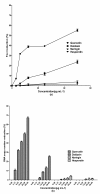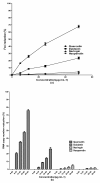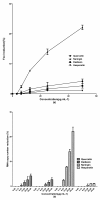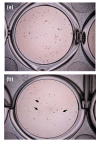Antiviral activity of four types of bioflavonoid against dengue virus type-2
- PMID: 22201648
- PMCID: PMC3271998
- DOI: 10.1186/1743-422X-8-560
Antiviral activity of four types of bioflavonoid against dengue virus type-2
Abstract
Background: Dengue is a major mosquito-borne disease currently with no effective antiviral or vaccine available. Effort to find antivirals for it has focused on bioflavonoids, a plant-derived polyphenolic compounds with many potential health benefits. In the present study, antiviral activity of four types of bioflavonoid against dengue virus type -2 (DENV-2) in Vero cell was evaluated. Anti-dengue activity of these compounds was determined at different stages of DENV-2 infection and replication cycle. DENV replication was measured by Foci Forming Unit Reduction Assay (FFURA) and quantitative RT-PCR. Selectivity Index value (SI) was determined as the ratio of cytotoxic concentration 50 (CC50) to inhibitory concentration 50 (IC50) for each compound.
Results: The half maximal inhibitory concentration (IC50) of quercetin against dengue virus was 35.7 μg mL-1 when it was used after virus adsorption to the cells. The IC50 decreased to 28.9 μg mL-1 when the cells were treated continuously for 5 h before virus infection and up to 4 days post-infection. The SI values for quercetin were 7.07 and 8.74 μg mL-1, respectively, the highest compared to all bioflavonoids studied. Naringin only exhibited anti-adsorption effects against DENV-2 with IC50 = 168.2 μg mL-1 and its related SI was 1.3. Daidzein showed a weak anti-dengue activity with IC50 = 142.6 μg mL-1 when the DENV-2 infected cells were treated after virus adsorption. The SI value for this compound was 1.03. Hesperetin did not exhibit any antiviral activity against DENV-2. The findings obtained from Foci Forming Unit Reduction Assay (FFURA) were corroborated by findings of the qRT-PCR assays. Quercetin and daidzein (50 μg mL-1) reduced DENV-2 RNA levels by 67% and 25%, respectively. There was no significant inhibition of DENV-2 RNA levels with naringin and hesperetin.
Conclusion: Results from the study suggest that only quercetin demonstrated significant anti-DENV-2 inhibitory activities. Other bioflavonoids, including daidzein, naringin and hesperetin showed minimal to no significant inhibition of DENV-2 virus replication. These findings, together with those previously reported suggest that select group of bioflavonoids including quercetin and fisetin, exhibited significant inhibitory activities against dengue virus. This group of flavonoids, flavonol, could be investigated further to discover the common mechanisms of inhibition of dengue virus replication.
Figures





Similar articles
-
Novel antiviral activity of baicalein against dengue virus.BMC Complement Altern Med. 2012 Nov 9;12:214. doi: 10.1186/1472-6882-12-214. BMC Complement Altern Med. 2012. PMID: 23140177 Free PMC article.
-
Extract of Scutellaria baicalensis inhibits dengue virus replication.BMC Complement Altern Med. 2013 Apr 29;13:91. doi: 10.1186/1472-6882-13-91. BMC Complement Altern Med. 2013. PMID: 23627436 Free PMC article.
-
Antiviral activity of baicalein and quercetin against the Japanese encephalitis virus.Int J Mol Sci. 2012 Dec 7;13(12):16785-95. doi: 10.3390/ijms131216785. Int J Mol Sci. 2012. PMID: 23222683 Free PMC article.
-
Antiviral Role of Phenolic Compounds against Dengue Virus: A Review.Biomolecules. 2020 Dec 24;11(1):11. doi: 10.3390/biom11010011. Biomolecules. 2020. PMID: 33374457 Free PMC article. Review.
-
Natural Compounds and Their Analogs as Antivirals Against Dengue Virus: A Review.Phytother Res. 2025 Feb;39(2):888-921. doi: 10.1002/ptr.8408. Epub 2024 Dec 19. Phytother Res. 2025. PMID: 39697048 Review.
Cited by
-
In silico pharmacokinetic and molecular docking studies of natural flavonoids and synthetic indole chalcones against essential proteins of SARS-CoV-2.Eur J Pharmacol. 2020 Nov 5;886:173448. doi: 10.1016/j.ejphar.2020.173448. Epub 2020 Aug 6. Eur J Pharmacol. 2020. PMID: 32768503 Free PMC article.
-
In vivo evaluation of the antiretroviral activity of Melia azedarach against small ruminant lentiviruses in goat colostrum and milk.Braz J Microbiol. 2024 Mar;55(1):875-887. doi: 10.1007/s42770-023-01174-0. Epub 2023 Nov 27. Braz J Microbiol. 2024. PMID: 38010582 Free PMC article.
-
Polyphenolic promiscuity, inflammation-coupled selectivity: Whether PAINs filters mask an antiviral asset.Front Pharmacol. 2022 Oct 21;13:909945. doi: 10.3389/fphar.2022.909945. eCollection 2022. Front Pharmacol. 2022. PMID: 36339544 Free PMC article. Review.
-
Phytotoxicity and Other Adverse Effects on the In Vitro Shoot Cultures Caused by Virus Elimination Treatments: Reasons and Solutions.Plants (Basel). 2021 Mar 31;10(4):670. doi: 10.3390/plants10040670. Plants (Basel). 2021. PMID: 33807286 Free PMC article. Review.
-
Natural and nature-inspired stilbenoids as antiviral agents.Eur J Med Chem. 2020 Sep 15;202:112541. doi: 10.1016/j.ejmech.2020.112541. Epub 2020 Jul 4. Eur J Med Chem. 2020. PMID: 32652408 Free PMC article. Review.
References
-
- Zandi K, Taherzadeh M, Yaghoubi R, Tajbakhsh S, Rastian Z, Sartavi K. Antiviral activity of Avicennia marina against herpes simplex virus type 1 and vaccine strain of poliovirus (An in vitro study) J Med Plant Res. 2009;3:771–775.
-
- Talarico LB, Damonte EB. Interference in dengue virus adsorption and uncoating by carrageenans. Virol. 2007;363:473–485. - PubMed
Publication types
MeSH terms
Substances
LinkOut - more resources
Full Text Sources
Other Literature Sources
Medical

